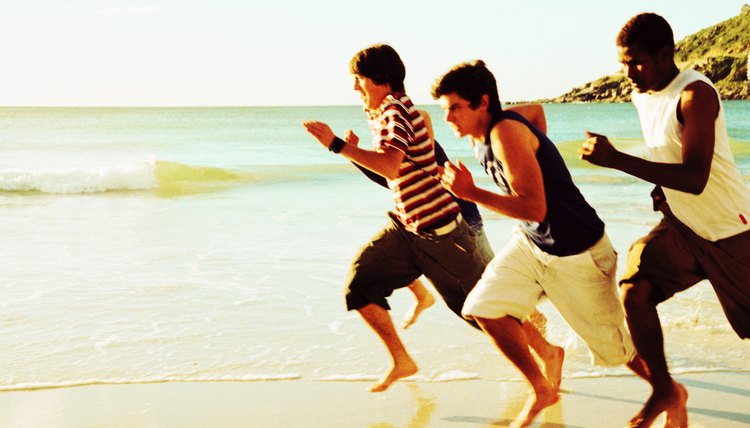Barefoot Running & Shin Splints

If you're a runner and you begin experiencing pain along the inner part of your lower legs, you most likely have shin splints. This could lead to inflammation and swelling and quickly put an end to your jogging session. Several studies have concluded that running barefoot not only improves your running stride but can also prevent shin splints.
Mechanics of Barefoot Running
Humans' feet are meant for running. More than 20 muscles and tendons in the foot are designed to cushion impact and propel your body forward. When running barefoot, you adapt your running stride to land midfoot instead of on the toes or heel. Also, the three major muscle groups of your calf stretch and absorb impact to give you a much longer running stride. BreakingMuscle.com reported that one study found barefoot running reduces the amount of time your foot makes contact with the ground and leads to a higher level of activation of the calf muscles.
Preventing Shin Splints
One of the most common injuries that runners face is shin splints, which is a painful strain on the tibia -- or shin bone -- and its surrounding muscle fibers. It's the repetitive impact of running, the constant stopping and starting that contributes to an excessive strain on the lower legs and feet. According to SportsScience.com, running barefoot actually reduces the risk of shin splints in competitive runners and casual joggers alike. When running barefoot, you actually increase the amount of flexion in the muscles of your foot to compensate for the lack of cushion provided by athletic footwear. This altered stride takes stress away from the tibia and helps prevent running injuries such as shin splints.
Dangers of Running Barefoot
Although humans have been running barefoot for thousands of years, today's runners must contend with broken glass and bottle caps on trails, roads and jogging paths. And while barefoot running minimizes shin splints, it might overtax muscles in your lower leg and foot, resulting in a calf strain, for example, or Achilles tendonitis. Because people are accustomed to wearing shoes -- especially during athletic activities -- running barefoot requires a period of adaptation. Start by simply walking barefoot and gradually work your way up to running.
Wearing Toe Shoes
Barefoot running might not always be practical, especially if you're susceptible to bruising, have weak arches or need increased ankle support. Toe shoes have become quite popular because they protect the bottoms of your feet while closely simulating the experience of running barefoot. These shoes provide a compromise between running with shoes and going barefoot, but they still don't allow you to toughen up the bottom surface of the foot. Still, you can use toe shoes to prevent shin splints and other injuries common to running athletes.
References
- Sport Science: Barefoot Running
- Breaking Muscle: Pros and Cons of Barefoot Running
- Callahan LR. Overview of running injuries of the lower extremity. Updated May 28, 2020.
- Alaia MJ. Diseases & Conditions: Shin Splints. OrthoInfo. American Academy of Orthopaedic Surgeons. Reviewed August 2019.
- Shin Splints. Merck Manual Professional Version.
- Shin splints - self care. MedlinePlus NIH.
Resources
Writer Bio
Frederick S. Blackmon's love for fiction and theater eventually led to a career writing screenplays for the film and television industry. While living in Florida, Blackmon began exploring issues on global warming, health and environmental science. He spent two years as a Parkour and free-running instructor as well. Now he writes everything from how-to blogs to horror films.
